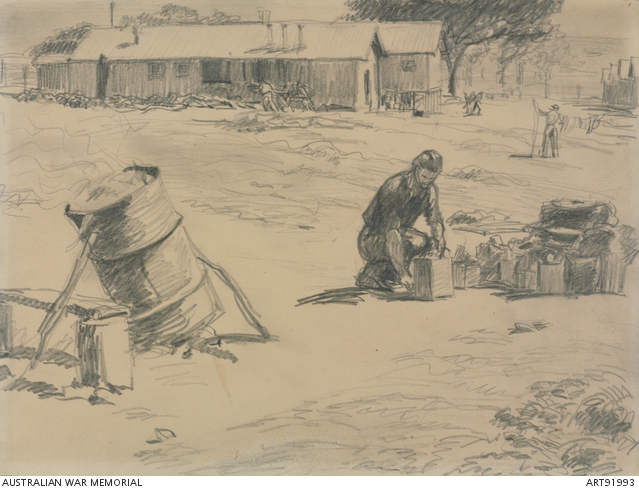| Places | |
|---|---|
| Accession Number | ART91993 |
| Collection type | Art |
| Measurement | Overall: 22.5 x 30.2 cm |
| Object type | Work on paper |
| Physical description | pencil on paper |
| Maker |
Hofmann, Robert |
| Place made | Australia: Victoria, Tatura |
| Date made | c 1942 |
| Conflict |
Second World War, 1939-1945 |
| Copyright |
Item copyright: AWM Licensed copyright |
Tatura Internment Camp, Victoria

Hofmann's drawing of the Tatura Internment Camp shows the camp buildings in the background and several figures going about their daily tasks. One man at right distance is hanging out the washing on a clothesline. Another in the foreground is crouching down over what appears to be tins containing water supplies. There is a large drum propped up with two sticks at the left foreground. The drum was possibly used as an incinerator. Robert Hofmann (1899-1987) painted in Poland and the Middle East during the First World War. In 1922 he received the Prix de Rome in Vienna. During 1930-1939 he was a court painter for the Hapsburg family, painting portraits. He had also been a Major in charge of a Turkish regiment. He moved to London in 1939, where he was employed with Harrods Emporium, drawing crayon portraits for 50 pounds each. Hofmann was one of the refugees sent by the British Government on the ship 'Dunera' travelling from Liverpool to Australia in 1940. On arrival in Melbourne in September 1940, 500 deportees disembarked and were transferred to the Tatura Internment Camp while the remaining men and youths went on to Sydney and were transferred to the Hay Camps, and subsequently to Tatura. Hofmann was one of the latter, taken first to Hay, New South Wales and later to Tatura in Victoria. In 1956 he moved to New York where he remained for the rest of his life.